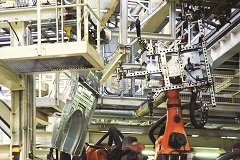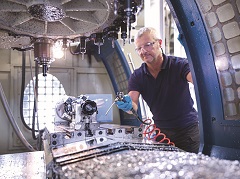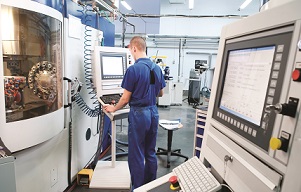

The industry benefits from high-tech innovations and advanced plant factory floors, but, as with many other industries, one thing threatens its progress – access to a skilled workforce capable of operating and keeping pace with today’s rapidly evolving technology.
Studies show that talent-driven innovation, based on the quality and availability of workers (skilled labor, as well as researchers, scientists and engineers), is the No. 1 driver of manufacturing competitiveness. In spite of this fact, finding, hiring and retaining employees with the right skills has proven to be a challenge.
Currently, there are 600,000 manufacturing jobs unfilled because people lack the job skills needed to perform in these positions, Baby Boomers are retiring and tools and technologies are advancing. With this number expected to grow to two million by 2025, manufacturers face an onslaught of hard-to-fill open positions in areas such as machining, welding, mechatronics, CNC programming, engineering, robotics and automation.
American manufacturers must regularly invest heavily in modern plants and cutting-edge equipment and operations to maintain productivity and competitive position. But many of those same manufacturers are not investing at all in their greatest opportunity.
Even with the threat of a shortfall of skilled workers, an SME survey found that more than 80 percent of companies acknowledge the skills gap problem, but less than 20 percent offer a structured manufacturing training program.
What Happened to America’s Skilled Workforce?
America continues to have one of the most advanced and skilled workforces in the world, yet 89 percent of manufacturers say they are having difficulty finding qualified talent. Not only does the lack of skilled workers contribute to increased overtime and production downtime, it also impacts business growth and innovation.
Four key factors are driving a shortage of advanced manufacturing workers: misconceptions of manufacturing, an aging workforce, the pace of technology and reshoring.
The pipeline of a STEM-educated (science, technology, engineering and math) workforce has undermined the misconceptions people have about working in manufacturing. Parents and counselors have steered students away from careers in this industry and other STEM education-based areas. Even more discouraging is that younger generations are less likely to pursue a career in this field because long-held negative public perceptions of manufacturing ignore today’s advanced factories and evoke images of dark, dirty and dangerous work environments.

The increased pace of technology is bringing vast changes to the industry. At no other time has technical innovation moved so quickly. This is great news for growing companies and their financial success, but this can be a challenge for workers who can’t keep up with the rapid pace of change. In the end, many companies are unable to leverage the tremendous opportunity for advancement through the adoption of new technology. While the demand for unskilled labor has decreased, it is becoming harder for skilled workers to stay current with the latest technology and processes.
Reshoring is increasing the need for skilled workers on U.S. soil. The good news is the movement to bring manufacturing operations back to the U.S. is creating an even greater opportunity for well-paying jobs. However, the bad news is the movement to bring operations back to the U.S. is creating an even greater need for skilled manufacturing workers – workers who currently don’t exist.
All of this explains why we’re seeing a disconnect between the demand for skilled employees and the availability of manufacturing talent. But with today’s integrated technologies and advanced factory floors, companies cannot afford to avoid or delay the professional development of their people. They have to establish or ramp up learning and development programs that will give their existing and new employees the right skillset to run their operations.
How Do We Solve the Skills Gap?
The skills gap issue may seem like a big challenge to tackle, but there are measures companies can take to minimize its impact on their operations.
This begins with assessing the current competency level of their workforce and from there determining employee training needs.
For those small- to medium-size manufacturers that think their company cannot afford an in-house training program, fortunately, there are governments, academic institutions and businesses in many areas of the country offering workforce development programs to help manufacturers find – and train – the skilled workers they need to continue growing their operations.
For instance, the Robert C. Byrd Institute for Advanced Flexible Manufacturing (RCBI) in West Virginia is helping local manufacturers look at innovative ways to address the national skills gap. At West Virginia’s Advanced Manufacturing Technology Center, RCBI offers a variety of general and customized training courses that include its Machinist Technology/CNC Program, which includes a college degree option, as well as its model apprenticeship programs.
RCBI’s customized programs range from a two-day blueprint-reading class to a four-year apprenticeship program conducted onsite at a local manufacturer’s shop. Integrating online curriculum from Tooling U-SME is part of a blended learning approach that also includes on-the-job (OTJ) training.
RCBI works with diverse groups including Wider Opportunities for Women (WOW), and presents summer camps and participates in career and job fairs that emphasize today’s “new manufacturing” to help showcase the reality of today’s production lines and shop floors.

Why Training Matters
Manufacturers that establish robust learning and development programs enable themselves to improve their operation continuously, develop and leverage their full workforce’s potential, increase employee engagement and efficiently and innovatively manufacture products in their facilities.
A well-trained workforce is a competitive advantage allowing companies to drive innovation, customer satisfaction, quality, productivity and growth. The beneficial by-products are engaged and loyal employees, satisfied stakeholders and a thriving economy.
Training and professional development are not only vital for manufacturing success but essential tactics in attracting and retaining Millennial workers who demand ongoing learning and new opportunities.
Manufacturing is in the midst of an exciting revolution in new technologies, ideas and opportunities. However, as factory floors become more advanced and demand expands across the country, employee development programs are becoming increasingly critical to manufacturing success. A bright new future exists in this industry and by investing in a company’s most valuable asset – its employees – businesses can improve worker retention, boost productivity, strengthen product quality and ensure their global competitiveness.

